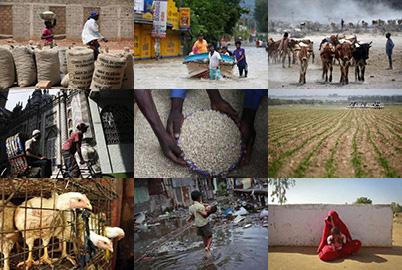A new survey finds 70% of respondents left home after extreme weather shocks hit their livelihoods, in a bid to find work elsewhere
By Anuradha Nagaraj
CHENNAI, India, Oct 26 (Thomson Reuters Foundation) - A rise in extreme weather events in India - from droughts and floods to heatwaves and hailstorms - is fuelling climate migration as the nation's poorest are forced to abandon their homes, land and livelihoods, researchers said on Tuesday.
In a survey of more than 1,000 households across three Indian states, nearly 70% of respondents said they migrated immediately after such weather disasters occur, found the International Institute for Environment and Development (IIED).
Seasonal migration was high among people affected by droughts and floods that damaged crops, or by cyclones that hampered fishing, according to the study, one of the first to quantify the impacts of climate change on migration in India.
Many of India's poorest people - such as small farmers - are finding it harder to cope with the damage caused by severe weather as the country braces for rising sea levels, more heatwaves and fiercer cyclones, researchers said.
"The scale of climate migration is startling," said Ritu Bharadwaj, a senior researcher at IIED and co-author of the report. "We cannot afford to pretend this isn't happening."
"Droughts, rising sea levels and flooding are heaping extra pressure onto people who are already struggling to get by, forcing them from their homes in order to survive."
The Global Climate Risk Index 2021, an annual ranking from research group Germanwatch, puts India among the top 10 countries most affected by climate change.
In 2020 alone, India suffered its worst locust attack in decades, three cyclones, a nationwide heatwave and flooding that killed hundreds of people and forced thousands more to migrate.
"The limits to people's resilience have been breached by more frequent and intense weather," Bharadwaj told the Thomson Reuters Foundation.
"Communities are not able to cope and recover easily. The loss and damage they suffer is very high and they migrate because they have reached the stage of hopelessness."
'NEED TO PLAN'
India's first climate change assessment report, published in 2020, projected that temperatures would rise 4.4 degrees Celsius by the end of the century in a "business as usual" scenario.
The frequency of heatwaves will be up to four times higher, cyclone intensity will increase and sea level will rise by 30 cm (12 inches) if action is not taken, the report said.
Researchers at the IIED interviewed people from Uttar Pradesh, Madhya Pradesh and Rajasthan states, where seasonal migration is prevalent.
Many leave home when there is little work in farming or fishing to find jobs on construction sites or in cotton fields in Maharashtra, Gujarat and New Delhi.
More than 70% of households in the study said droughts were happening significantly more often in the last 5 to 10 years, leading to an increase in so-called distress migration when people feel they have no other option to survive.
"We need to plan for the hundreds of millions of people who it is predicted will have to migrate in the coming decades due to climate change," Bharadwaj said.
India's social protection programmes do not consider extreme weather and were not designed to build climate resilience, the IIED said.
The national rural employment guarantee scheme - which promises 100 days of work per year to every household - does not act as "a viable safety net" due to delays in wage payments and a lack of transparency, the report said.
Besides revamping existing mechanisms, Bharadwaj said there was a need for pre-emptive action before a disaster strikes.
Making migration safe for people forced to move by climate pressures should involve "anticipatory wage employment" and portability of social protection entitlements, the IIED said.
Related stories:
'Chaotic' monsoons threaten India's farmers without climate action
With Assam silk and trees, Indians fight climate change and trafficking
Unequal risk: How climate change hurts India's poor most
(Reporting by Anuradha Nagaraj @AnuraNagaraj; Editing by Kieran Guilbert and Megan Rowling. Please credit the Thomson Reuters Foundation, the charitable arm of Thomson Reuters, that covers the lives of people around the world who struggle to live freely or fairly. Visit http://news.trust.org)
Our Standards: The Thomson Reuters Trust Principles.

